Performance Evaluation of Fiber-Reinforced, Stress Relief Asphalt Layers to Suppress Reflective Cracks
Abstract
:1. Introduction
2. Objectives
3. Performance Evaluation of F-SAMI Specimens Using MMLS3
3.1. Specimen Preparation for MMLS3 (Model Mobile Load Simulator 3) Test
3.2. Experimental Condition for MMLS3 Test
3.3. MMLS3 Test Results
4. Performance Evaluation Using Accelerated Pavement Testing (APT)
4.1. Accelerated Pavement Testing (APT) Facility
4.2. Test Section Layout and Test Configuration
- ◦
- Load condition: dual-wheel load, 80 kN, 10 km/h, one-way loading
- ◦
- Load wandering: center-based, bidirectional 430 mm
- ◦
- Temperature condition: the surface temperature of the pavement is maintained at 20~25 °C using an air-conditioning system
- ◦
- Total number of loads: 200,000 load passes
4.3. Test Results of APT
5. Conclusions
Funding
Conflicts of Interest
References
- Eum, J.; Yang, S.; Jung, C. Methodology for Constraining Asphalt Concrete Overlay Against Reflection Cracking; Report No. 99-47-19; Korea Highway Corporation: Seongnam-si, Korea, 1999. [Google Scholar]
- Kwon, O.; Moon, K.; Kim, J.; Lee, J. A Study of Application Method of Asphalt Overlay on Aged Concrete Pavement; Report No. KECRI-2017-31-534.9607; Expressway & Transportation Research Institute: Dongtan-si, Korea, 2017. [Google Scholar]
- Seo, Y.C.; Lee, Y.M.; Kim, J.H.; Cho, N.H. Behavior and Resistance to the Reflection Crack of Composite Pavement with Waterproof Membrane. Int. J. Highway Eng. 2012, 14, 1–10. [Google Scholar]
- Hughes, C.S. Mitigation of Reflection Cracks in Flexible Pavements; Final Report No. VHTRC 78-R5; Virginia Highway and Transportation Research Council: Charlottesville, VA, USA, 1977. [Google Scholar]
- Mascunana, I. An Evaluation of Engineering Fabric in Pavement Rehabilitation; Final Report No. IHD-21; Illinois Department of Transportation: Springfield, IL, USA, 1981.
- McGhee, K.H. Control of Reflection Cracking in a Fabric-Reinforced Overlay on Jointed Portland Cement Concrete Pavement; Report No. VHTRC 83-R8; Virginia Highway and Transportation Research Council: Charlottesville, VA, USA, 1983. [Google Scholar]
- Barksdale, R.D. Fabrics in Asphalt Overlays and Pavement Maintenance; NCHRP Synthesis Report 171; National Cooperative Highway Research Program, National Research Council: Washington, DC, USA, 1991. [Google Scholar]
- Mukhtar, M.; Dempsey, B.J. Interlayer Stress Absorbing Composite (ISAC) for Mitigating Reflection Cracking in Asphalt Concrete Overlays; Final Report No. UILU-ENG-96-2006; Illinois Department of Transportation: Springfield, IL, USA, 1996.
- Carmichael, R.F.; Marienfeld, M.L. Synthesis and Literature Review of Nonwoven Paving Fabrics Performance in Overlays. Transp. Res. Rec. J. Transp. Res. Board. 1999, 1687, 112–124. [Google Scholar] [CrossRef]
- Bischoff, D. Evaluation of Strata® Reflective Crack Relief System; Final Report No. FEP-01-07; Wisconsin Department of Transportation: Madison, WI, USA, 2007.
- Ahlrich, R.C. Evaluation of Asphalt Rubber and Engineering Fabrics as Pavement Interlayers; Final Report No. GL-86-34; Army Corps of Engineers: Washington, DC, USA, 1986. [Google Scholar]
- Lytton, R.L. Use of Geotextiles for Reinforcement and Strain Relief in Asphaltic Concrete. Geotextiles and Geomembranes. J. Int. Geosynth. Soc. 1989, 8, 217–237. [Google Scholar]
- Epps, J.A. Synthesis of Highway Practice 198: Use of Recycled Rubber Tires in Highways. National Cooperative Highway Research Program (NCHRP); Transportation Research Record National Research Council: Washington, DC, USA, 1994. [Google Scholar]
- Amini, F. Potential Applications of Paving Fabrics to Reduce Reflective Cracking; Report No. MS-DOT-RD-05-174; Mississippi Department of Transportation: Jackson, MS, USA, 2005.
- Shatnawi, S. Maintenance Technical Advisory Guide; Volume I-Flexible Pavement Preservation Section Edition; State of California Department of Transportation: Sacramento, CA, USA, 2008.
- Bush, A.J.; Brooks, E.W. Geosynthetic Materials in Reflective Crack Prevention; Final Report No. SR 537; Oregon Department of Transportation Research Unit: Salem, OR, USA, 2007.
- Lorenz, V.M. New Mexico Study of Interlayers Used in Reflective Crack Control; Transportation Research Record. J. Transp. Res. Board. 1987, 1117, 94–103. [Google Scholar]
- Buttlar, W.G.; Dempsey, B.J.; Bozkurt, D. Evaluation of Reflective Crack Control Policy; Report No. ITRC FR 95/96-4; Illinois Transportation Research Center: Edwardsville, IL, USA, 1999. [Google Scholar]
- Vespa, J.W. An Evaluation of Interlayer Stress Absorbing Composite (ISAC) Reflective Crack Relief System; Final Report No. FHWA/IL/PRR 150; Illinois Department of Transportation: Springfield, IL, USA, 2005.
- Elseifi, M.; Bandaru, R. Cost Effective Prevention of Reflective Cracking of Composite Pavement; Final Report; Louisiana Department of Transportation: Hammond, LA, USA, 2011.
- Brown, S.F.; Brunton, J.M.; Hughes, D.A.B.; Brodrick, B.V. Polymer Grid Reinforcement of Asphalt. Assoc. Asph. Paving Technol. 1985, 54, 18–44. [Google Scholar]
- Gilchrist, A.J.T. Control of reflection cracking in pavements by the installation of polymer geogrids. In Proceedings of the Conference on Reflective Cracking in Pavements, Liege, Belgium, 3–6 October 1994; pp. 350–357. [Google Scholar]
- Park, H.M.; Kim, Y.T.; Choi, J.Y.; Kim, K.H. A Preliminary Study for Assessing the Risk of Road Collapse Using Accelerated Pavement Testing. Int. J. Highway Eng. 2016, 18, 57–62. [Google Scholar] [CrossRef]

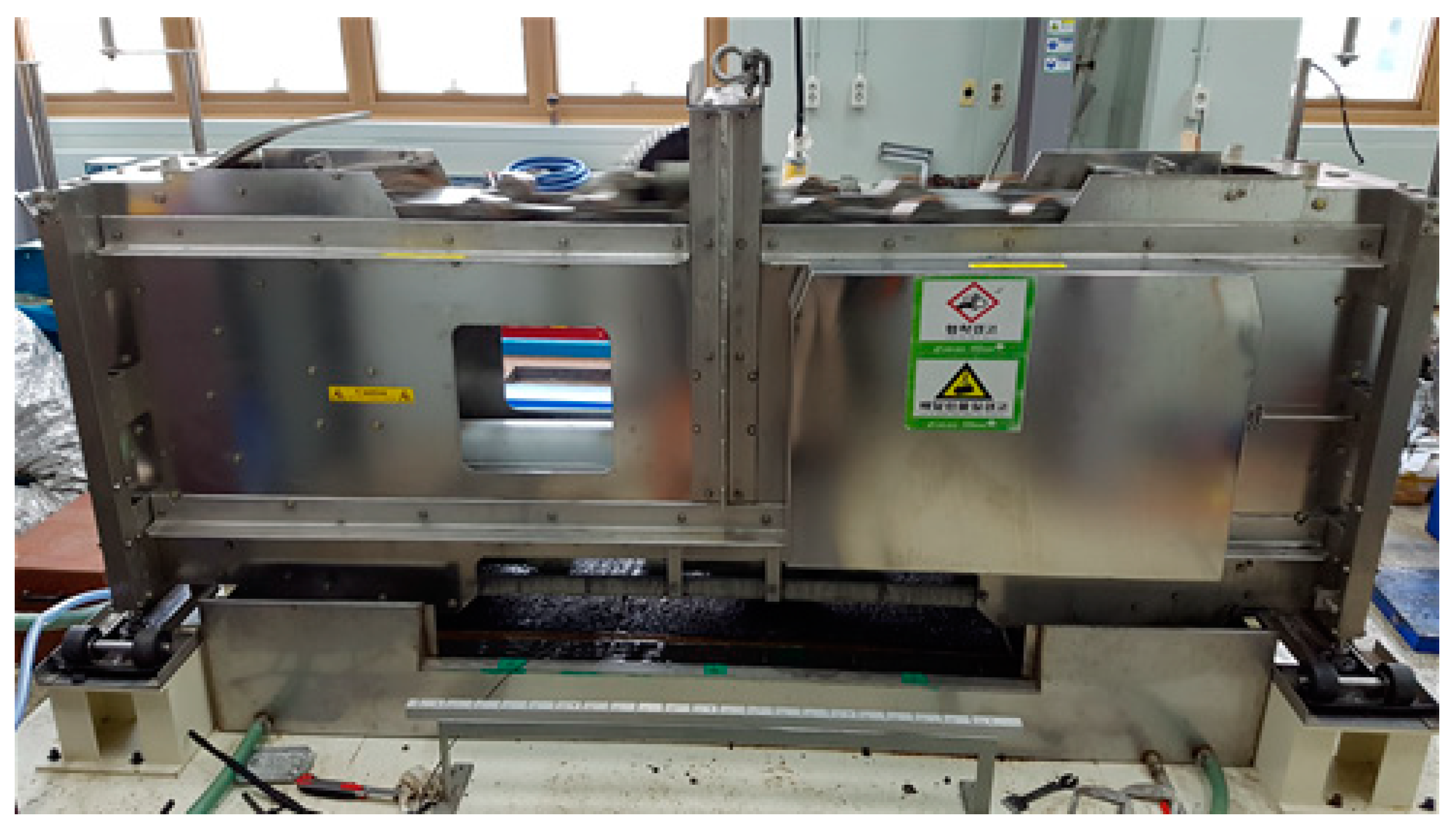
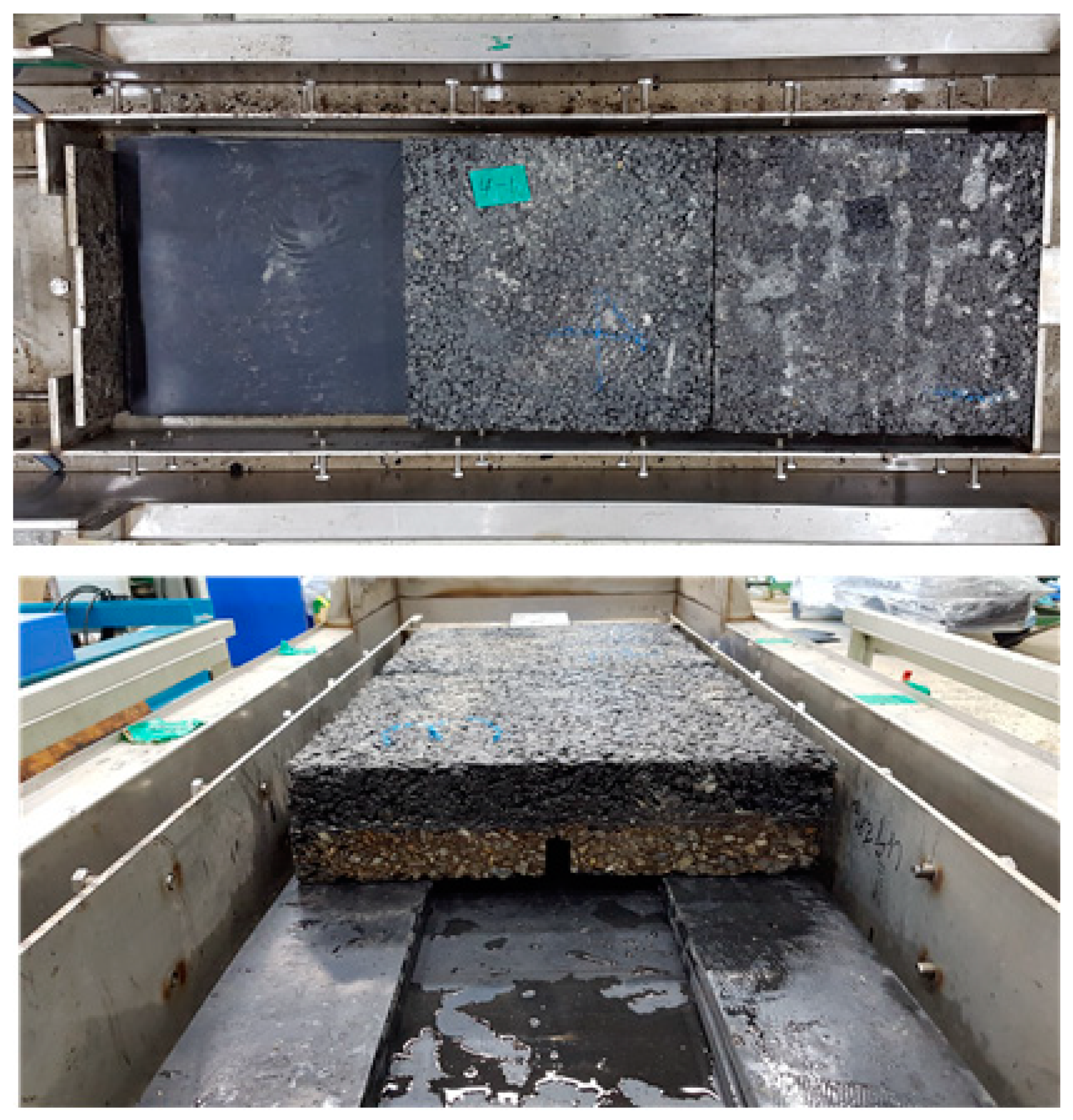
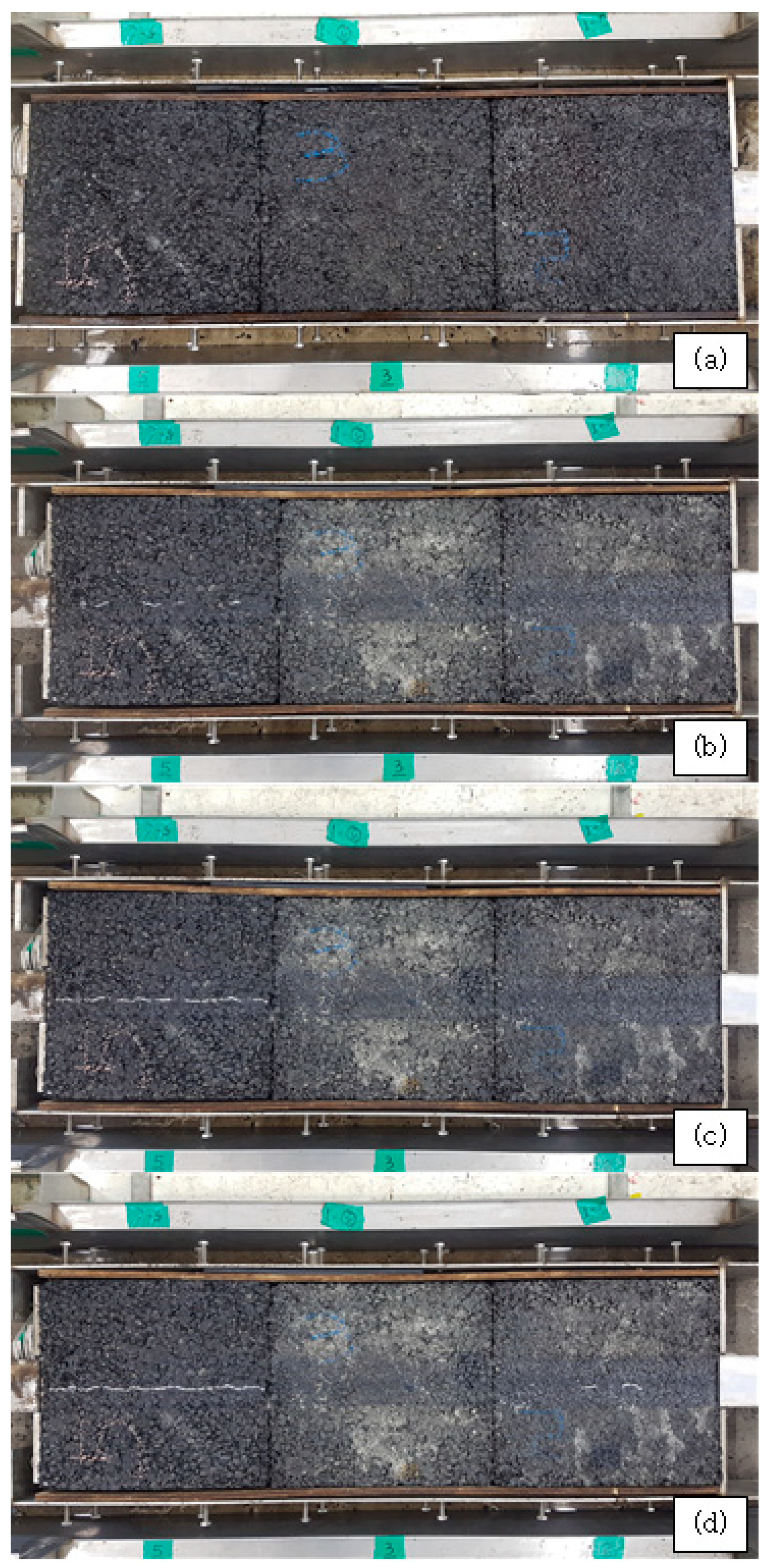
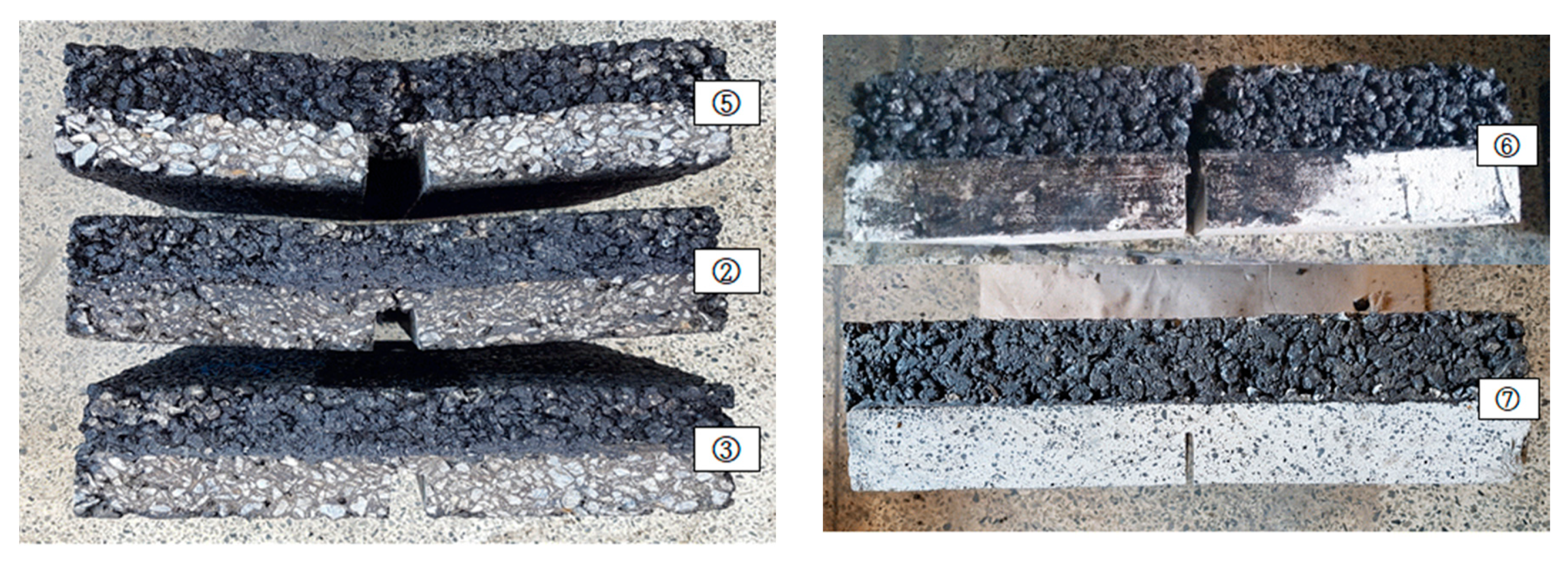

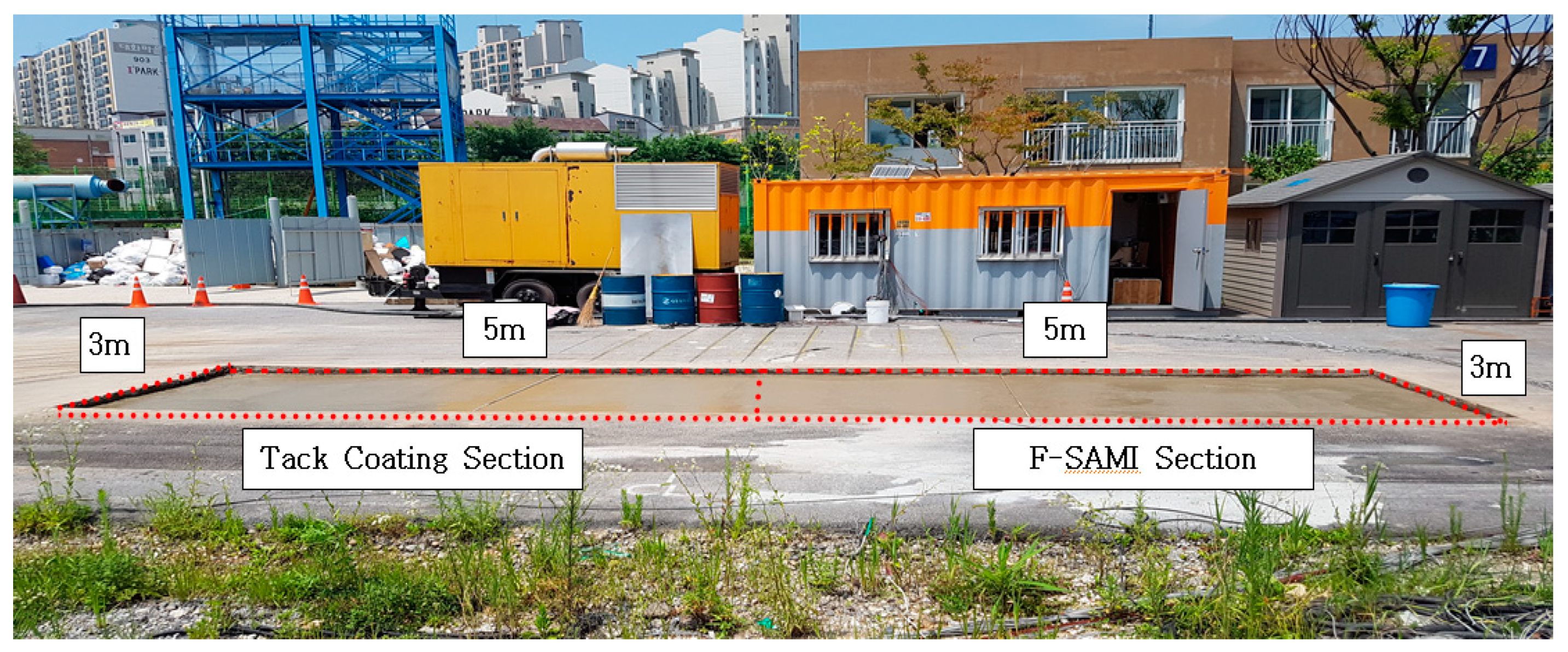
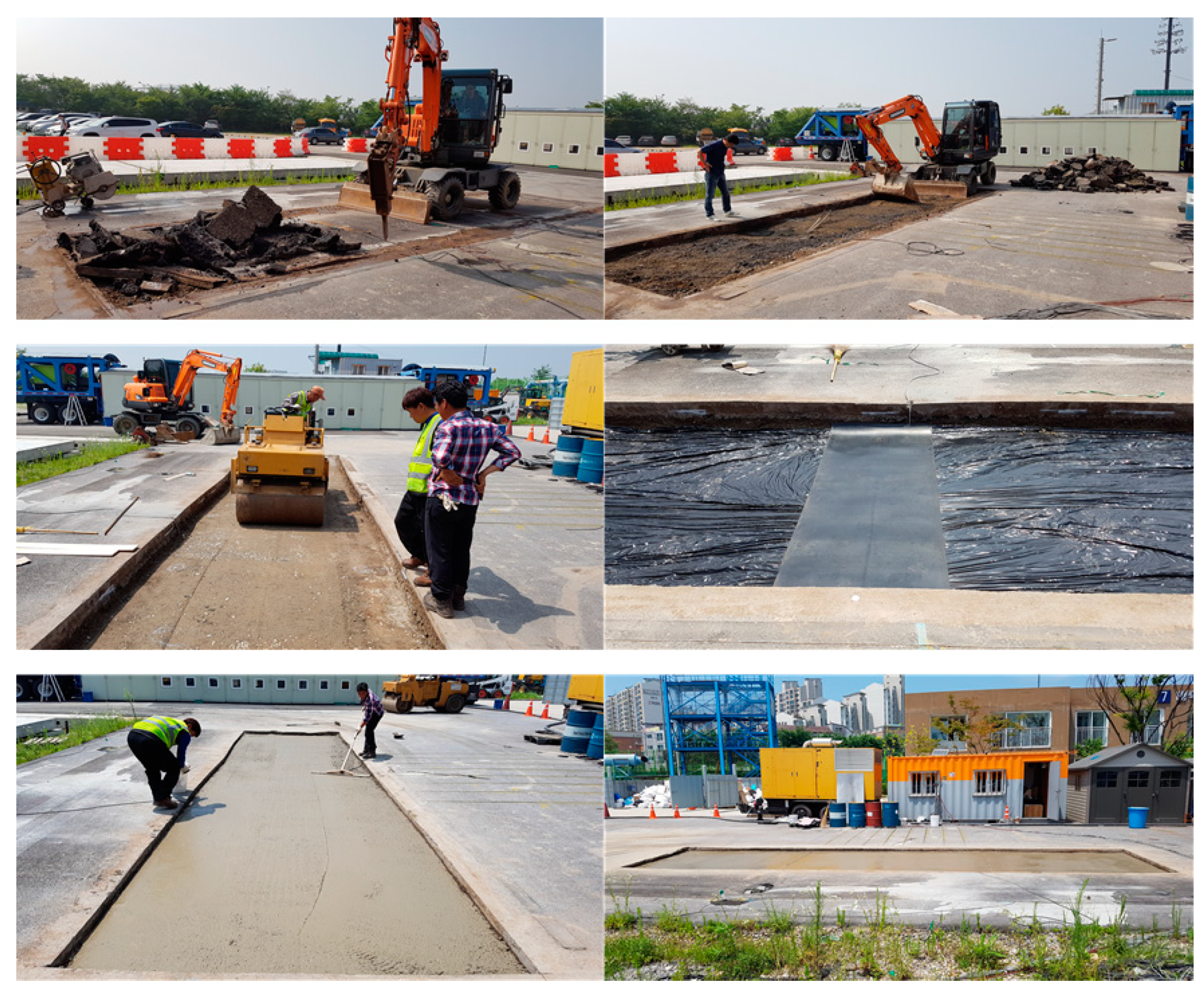
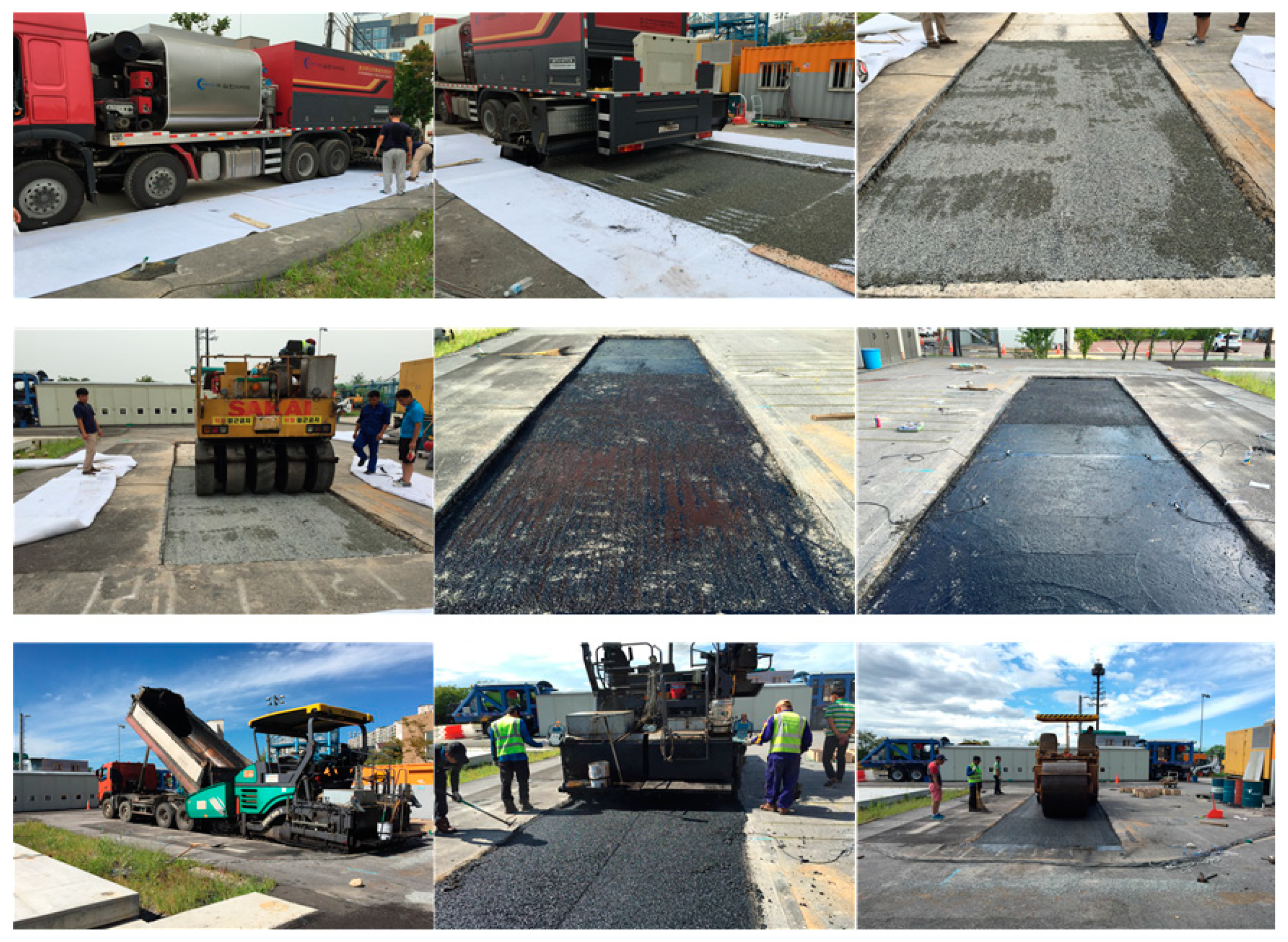
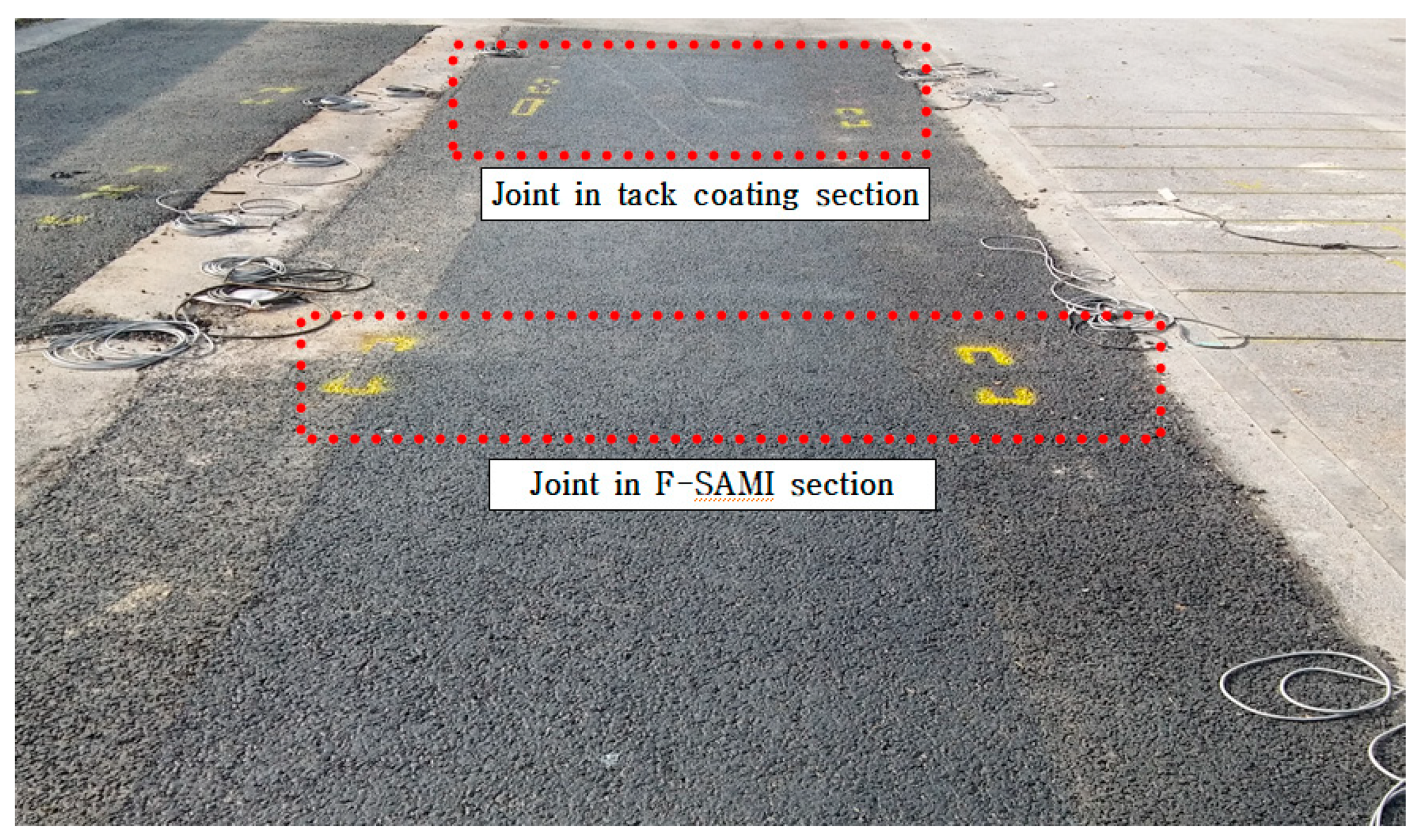
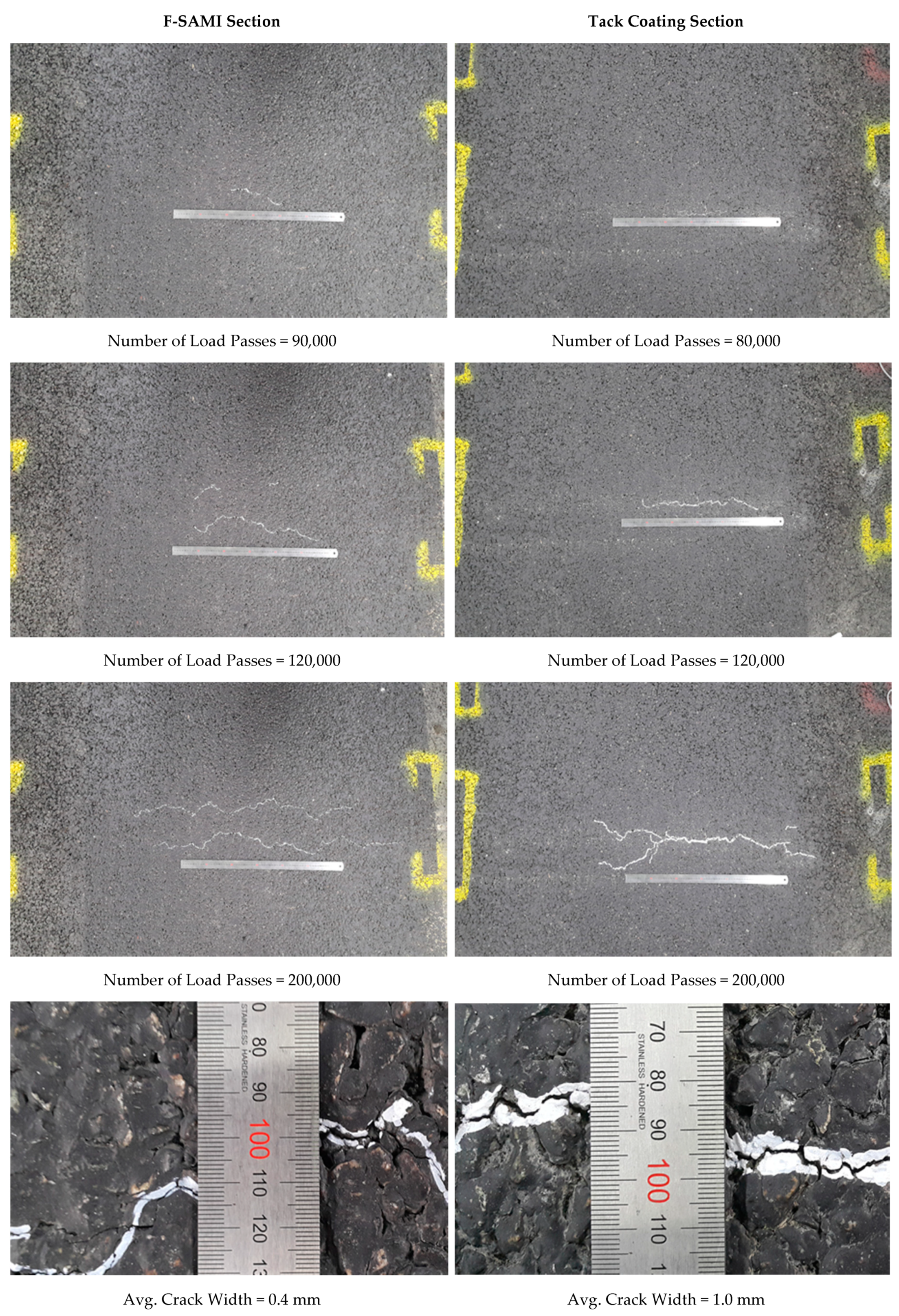
| Specimen Composition | Material Type and Grade | Remark | ||
|---|---|---|---|---|
| Lower Layer | Asphalt Mix | Dense grade 19 mm + PG 64–22 | t = 5 cm | |
| Concrete Mix | Ready-mixed concrete for pavement | t = 5 cm | ||
| Top Layer | Asphalt Mix | PSMA 13 mm + PG 76–22 | t = 5 cm | |
| Adhesion Layer | Tack Coating | Emulsified asphalt (RSC-grade) | 0.6 L/m2 | |
| F-SAMI | Asphalt | Polymer-modified asphalt (PG 76–22) | 2.5 L/m2 | |
| Fiber | Glass fiber (length: 30~40 mm, diameter: 13 µm, tensile strength: 2 GPa) | 70 g/m2 | ||
| Aggregate | Single size aggregate (8 mm, granite) | 4 kg/m2 | ||
| Specimen Number | Specimen Composition | Adhesion Layer Composition | ||
|---|---|---|---|---|
| Binder Application Rate (L/m2) | Fiber Application Rate (g/m2) | Aggregate Application Rate (kg/m2) | ||
| ① | Lower layer—asphalt mixture, Top layer—asphalt mixture | 2.5 | 70 | 4 |
| ② | 3.0 | 70 | 4 | |
| ③ | 2.0 | 70 | 4 | |
| ④ | 2.5 | 70 | 0 | |
| ⑤ | Tack Coating | |||
| ⑥ | Lower layer—concrete mixture, Top layer—asphalt mixture | Tack Coating | ||
| ⑦ | 2.5 | 70 | 4 | |
| Specimen Number | Number of Loadings until Cracking on the Surface of Specimen (Nf) |
|---|---|
| ① | 886,000 |
| ② | 1,020,000 |
| ③ | More than 1,020,000 |
| ④ | 736,000 |
| ⑤ | 600,000 |
| ⑥ | 142,600 |
| ⑦ | More than 582,600 |
| Test Section Composition | Material Type and Grade | Remark | ||
|---|---|---|---|---|
| Lower Layer | Sub-base | Crushed aggregate (40 mm) | t = 15 cm | |
| Concrete mix | Ready-mixed concrete for pavement | t = 15 cm | ||
| Upper Layer | Asphalt mix | PSMA 13 mm + PG 76–22 | t = 5 cm | |
| Adhesion Layer | Tack coating | Emulsified asphalt (RSC grade) | 0.6 L/m2 | |
| F-SAMI | Asphalt | Polymer-modified asphalt (PG 76–22) | 1.8 L/m2 | |
| Fiber | Glass fiber (length: 30~40 mm) | 40 g/m2 | ||
| Aggregate | Single size aggregate (8 mm, granite) | 6 kg/m2 | ||
Publisher’s Note: MDPI stays neutral with regard to jurisdictional claims in published maps and institutional affiliations. |
© 2020 by the author. Licensee MDPI, Basel, Switzerland. This article is an open access article distributed under the terms and conditions of the Creative Commons Attribution (CC BY) license (http://creativecommons.org/licenses/by/4.0/).
Share and Cite
Baek, C. Performance Evaluation of Fiber-Reinforced, Stress Relief Asphalt Layers to Suppress Reflective Cracks. Appl. Sci. 2020, 10, 7701. https://doi.org/10.3390/app10217701
Baek C. Performance Evaluation of Fiber-Reinforced, Stress Relief Asphalt Layers to Suppress Reflective Cracks. Applied Sciences. 2020; 10(21):7701. https://doi.org/10.3390/app10217701
Chicago/Turabian StyleBaek, Cheolmin. 2020. "Performance Evaluation of Fiber-Reinforced, Stress Relief Asphalt Layers to Suppress Reflective Cracks" Applied Sciences 10, no. 21: 7701. https://doi.org/10.3390/app10217701
APA StyleBaek, C. (2020). Performance Evaluation of Fiber-Reinforced, Stress Relief Asphalt Layers to Suppress Reflective Cracks. Applied Sciences, 10(21), 7701. https://doi.org/10.3390/app10217701




